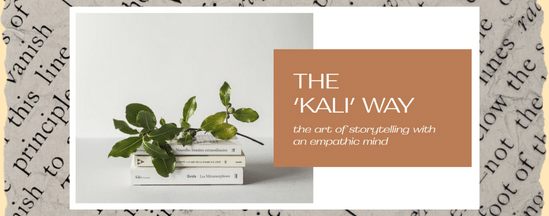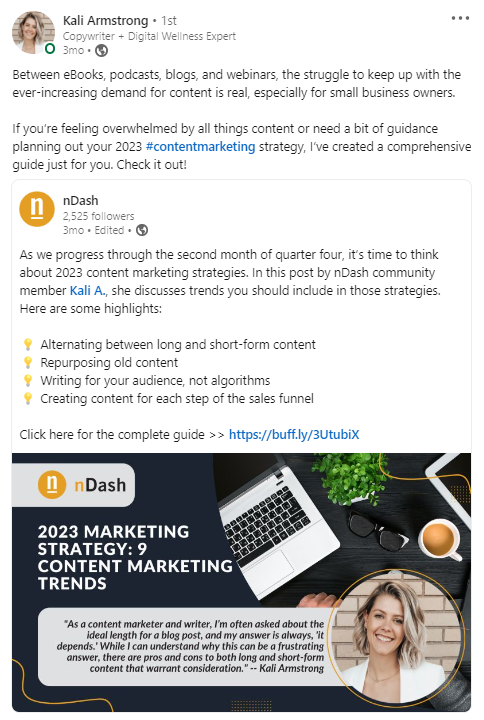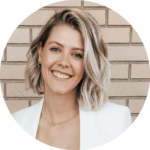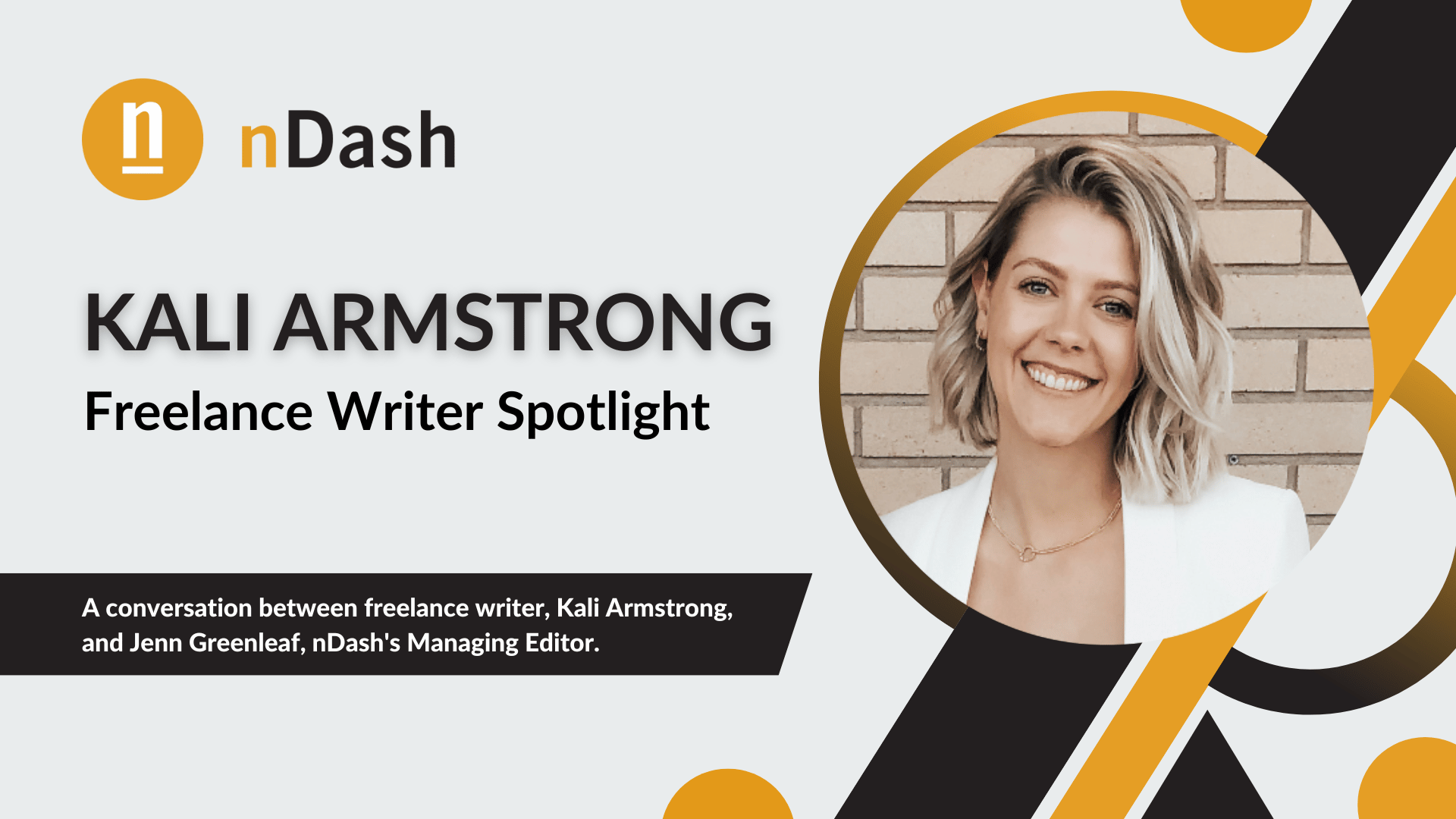nDash’s Managing Editor, Jenn Greenleaf, talks to Kali Armstrong about her transition from marketing and communications to becoming a full-time freelance writer and much more!
Background: The Highlights
Born and raised in Calgary, Kali Armstrong is a freelance writer who believes “that absolutely everyone has a story that deserves to be told!” Her services include:
- Content writing: Whether you need recurring blog posts to maintain website traffic, a stock pile of posts ahead of a launch, or a professional ghostwriter to craft industry articles on your behalf — I. Am. Here. For. It!
- Copywriting: I am not one for insects; I’ve become a bit of a wizard when it comes to developing a brand voice. So, whether you’re starting from scratch or fine-tuning existing copy, I’ll help you sound — well, more like yourself.
Here’s a snippet from Kali’s LinkedIn profile where she describes the services she offers:
“I help businesses organically expand their reach by creating value-driven content strategically designed to attract premium clientele.”
Becoming a Full-Time Freelance Writer: Kali’s Transition

Jenn: I see on your LinkedIn profile that you have several years of marketing and communications experience. Can you tell me a little bit about that and how it may have influenced your career as a freelance writer?
Kali: My undergrad was in Communications, so upon graduation, I naturally sought out marketing and communication roles. Although I found my initial roles in marketing interesting, I realized I enjoyed creating the content much more than coordinating the moving parts of a campaign, which led to my shift toward writing.
Having had several marketing and communication jobs, I recognize the importance of gearing content toward your audience. Whether it’s an internal memo going out to employees, or a ghostwritten industry article, I really make an effort to take on the mindset of my audience to ensure the content I’m writing speaks to their experience.
Recently, I’ve also found that my background in marketing can help me land clients as I am able to explain how a content strategy can serve their larger marketing objectives.
Jenn: What led you to become a freelance writer?
Kali: After working a few unfulfilling marketing roles at various companies, I knew there had to be a better option that gave me more freedom and control over the projects I worked on. I wanted to write, but I didn’t know where to start.
Fortunately, I had a friend who was about a year ahead of me in her freelance writing career that shared a website that hired freelancers. The pay was pretty bad, but I was getting bylines, so I stuck with it. From there, my confidence grew, my writing improved, and I was able to go after better opportunities. And as they say, the rest is history!
Jenn: How did nDash become part of your journey?

Kali: With so many content mills and bidding platforms out there, it can be really hard to find clients who see the value in quality content. Over the years, I’ve signed up for a few platforms just to see what was out there and was always disappointed by the opportunities.
After some research, I stumbled upon nDash and quickly realized it was different than the other platforms I had tried. It was really refreshing to find a platform that actually values freelance writers, pays them what they are worth, and doesn’t take a percentage of my earnings.
Jenn: What was the biggest challenge you faced when transitioning from marketing and communications to freelance writing?
Kali: The greatest challenge I faced as I transitioned from marketing to freelance writing was finding clients and proving my worth with minimal experience. Although I had worked in marketing and communication, I didn’t have the type of writing samples I needed. I felt like I was stuck in the “you can’t get a job without samples of your work, but you can’t get samples if no one hires you” vortex for some time.
Looking back, I should have created my own content geared toward companies or industries I wanted to work with. Still, at the beginning stages of my writing career, I didn’t have a solid grasp on what that would look like, nor did I have the confidence to cold pitch without any “real” samples.
Jenn: What advice can you give someone who wants to transition into freelance writing but is too nervous about taking that leap?
Kali: I have two pieces of advice for writers starting out:
- Don’t play the comparison game. No matter how much money you make or how many bylines you get, there will always (and I mean always) be someone who you think is doing “better” than you. There is room for everyone to succeed, so don’t let the accomplishments of others make you feel less than.
- You get what you put into it. When I first started out, my confidence was pretty low, which ultimately held me back from pitching to publications and really putting myself out there. It wasn’t until I started putting in the time and committing to the process that things finally started to shift for the better.
The Rest of nDash’s Discussion with Kali Armstrong
 Kali’s freelance writing background includes covering business, health and wellness, lifestyle, and real estate topics across numerous industries. Examples include digital wellness, real estate investing, brand storytelling, and more.
Kali’s freelance writing background includes covering business, health and wellness, lifestyle, and real estate topics across numerous industries. Examples include digital wellness, real estate investing, brand storytelling, and more.
Jenn: During the seven years that you’ve been a freelance writer, what organizational tools and other resources have worked best for you?
Kali: Whether it’s jotting down to-do lists and deadlines or organizing my thoughts for an article, nothing works as well for me as pen and paper.
If something is tripping me up or isn’t making sense, I have to physically write it down —the same goes for scheduling my workload. It’s a bit old school, but after trialing several different tools and platforms, I always go back to my trusty paper agenda and notebook.
Jenn: You list real estate, marketing, and digital wellness as your specialties – do you have a “favorite” niche you love receiving assignments for above all else?
Kali: While my personal interest in real estate and interior design is borderline obsessive (HGTV is often playing in the background as I work), I have a massive professional passion for digital wellness. During the pandemic, I lost quite a few clients and ended up taking a full-time communications role at a company that ended up being quite toxic.
In Canada, our Covid restrictions meant most non-essential businesses were closed, and employees had to work remotely for extended periods of time. Although working from home naturally blurs the lines between work and personal life, the company I worked for took complete advantage. The expectations placed on our marketing team to work well beyond regular working hours (sometimes until 11:00 pm) were unreasonable and quickly wore the entire team down.
Around the same time, I enrolled in a digital wellness program a past client of mine was running, which solidified my passion. So, anytime I can share that knowledge by writing about digital wellness and providing actionable tips that can help those struggling to set boundaries or disconnect, feels pretty good.
Jenn: I notice on your website that you mention that you “only take on a select number of clients to ensure each one of you gets my undivided attention.” How do you choose which clients to move forward with and which to pass on?
Kali: This can be tricky, and I’ve definitely taken on some clients throughout my career that I wish I hadn’t. At the end of the day, you learn from experience. For starters, trust your gut. If the vibes are off during an intro call, a prospective client is making you feel like you need to justify your worth or trying to add in additional deliverables outside of your existing scope of work. It’s probably not going to get better from there.
These days, I try only to take on projects that are either within my niche or that I have personal interest in. Stepping too far outside that can be a massive time suck and prevent you from going after opportunities that would be better suited for your skillset.
Jenn: How do you define the “perfect” client? And conversely, how do you define one that is less desirable?
Kali: The perfect client will trust your ability as a writer, see the value you bring to the table, and pay you on time! In my experience, less desirable clients tend to be nit-picky from the beginning, don’t allow much creative freedom, and try to get away with scope creep.
Jenn: I love that you mention Tilly, Head of Barketing and Employee Wellness! (My “Head of Barketing” is Sophie. 🙂) Your mention of work-life balance in Tilly’s blurb stands out – what advice do you have for those who are struggling with this?
Kali: Ask yourself if you’re working to live or living to work. If it’s the latter, it might be time to step back and re-evaluate your priorities. While it can be tempting to fill up your calendar with as many clients as possible, taking on too many projects rarely ends well.
You’ll burn out, the quality of your work will suffer, and the effects on your personal life can be long-lasting. So, be honest with yourself about how much work you can handle, pop your deadlines into a calendar, and don’t forget to schedule things that bring you joy.
For me, that includes a daily walk with my Head of Barketing, logging off early a few times a week to hit the gym, and prioritizing mealtime with family. It might sound a bit silly to schedule these things, but without a little reminder, you can easily put them off for weeks at a time — and that’s when you’ll really start to feel the burnout.
Thank you for chatting with us about your transition from marketing and communications to becoming a full-time freelance writer and everything in between!
Work With Kali Armstrong on nDash Today!
Do you have a project that aligns with Kali’s background? Check out her writer profile to see her work and how her experience can help level up your content strategy: Kali Armstrong.

